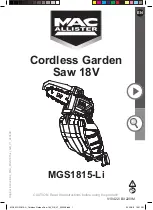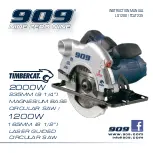
6
TABLE SAW SAFETY
SAW BLADE GUARD ASSEMBLY, ANTI-KICKBACK
ASSEMBLY AND RIVING KNIFE
Your table saw is equipped with a blade guard assembly,
anti-kickback assembly and riving knife that covers the
blade and reduces the possibility of accidental blade
contact. The riving knife is a flat plate that fits into the cut
made by the saw blade and effectively fights kickback
by lessening the tendency of the blade to bind in the cut.
The blade guard assembly and anti-kickback assembly
can only be used when making through cuts that sever
the wood. When making rabbets and other cuts that
make non through cuts, the blade guard assembly and
anti-kickback assembly must be removed and riving
knife lowered to the non through cut position marked on
the riving knife. Two anti-kickback pawls are located on
the sides of the riving knife that allow the wood to pass
through the blade in the cutting direction but reduce
the possibility of the material being thrown backwards
toward the operator. Use all components of the guarding
system (blade guard assembly, riving knife and anti-
kickback assembly) for every operation for which they
can be used including all through cutting. If you elect
not to use any of these components for a particular
application exercise additional caution regarding control
of the workpiece, the use of push sticks, the position
of your hands relative to the blade, the use of safety
glasses, the means to avoid kickback and all other
warnings contained in this manual and on the saw itself.
Replace the guarding systems as soon as you return
to thru-cutting operations. Keep the guard assembly in
working order.
KICKBACKS
KICKBACKS: Kickbacks can cause serious injury. A
kickback occurs when a part of the workpiece binds
between the saw blade and the rip fence, or other fixed
object, and rises from the table and is thrown toward the
operator. Kickbacks can be avoided by attention to the
following conditions.
How to Avoid Them and Protect Yourself from
Possible Injury:
a. Be certain that the rip fence is parallel to the saw
blade.
b. Do not rip by applying the feed force to the section of
the workpiece that will become the cut-off (free) piece.
Feed force when ripping should always be applied
between the saw blade and the fence; use a push stick
for narrow work, 6 in. (152 mm) wide or less.
c. Keep saw blade guard assembly, riving knife and anti-
kickback assembly in place and operating properly. If
anti-kickback assembly is not operational, return your
unit to the nearest authorized service center for repair.
The riving knife must be in alignment with the saw
blade and the anti-kickback assembly must stop a
kickback once it has started. Check their action before
ripping by pushing the wood under the anti-kickback
assembly. The teeth must prevent the wood from being
pulled toward the front of the saw.
d. Plastic and composite (like hardboard) materials may
be cut on your saw. However, since these are usually
quite hard and slippery, the anti-kickback pawls may
not stop a kickback. Therefore, be especially attentive
to following proper set up and cutting procedures for
ripping.
e. Use saw blade guard assembly, anti-kickback
assembly and riving knife for every operation for which
it can be used, including all through-sawing.
f. Push the workpiece past the saw blade prior to release.
g. Never rip a workpiece that is twisted or warped, or
does not have a straight edge to guide along the
fence.
h. Never saw a large workpiece that cannot be controlled.
i. Never use the fence as a guide or length stop when
crosscutting.
j. Never saw a workpiece with loose knots, flaws, nails or
other foreign objects.
k. Never rip a workpiece shorter than 10 in. (254 mm).
l. NEVER use a dull blade – replace or have
resharpened.
m.NEVER use a rip fence and miter gauge together.
n. Keep hands out of saw blade.







































